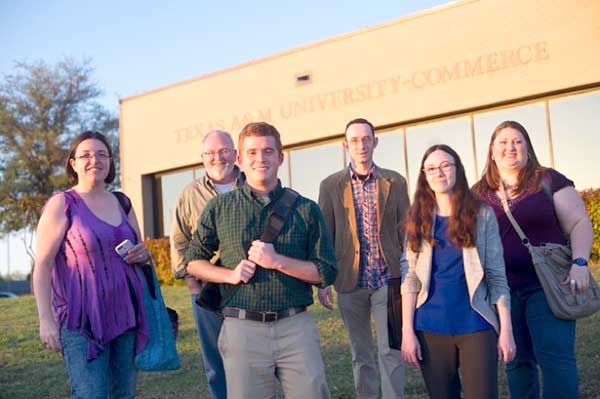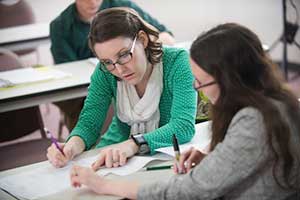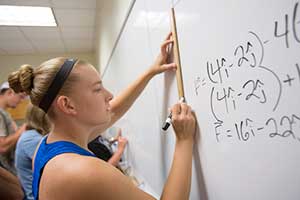Teacher Preparation at Texas A&M University-Commerce
William Newton, Texas A&M Commerce
The Context: Who We Are and Where We Started
Texas A&M University-Commerce is the second largest campus in the A&M system. Its enrollment of 13,000 is drawn from rural northeastern Texas and the Dallas-Fort Worth metroplex. It is a primarily undergraduate and Master's institution, and has historically had a focus on teacher preparation.
The Department of Physics and Astronomy has 9 faculty, and graduates an average of 5 undergraduates and 5 Master's students yearly. Although our department has a physics teacher preparation program and a Master’s track for in-service teachers, they had lain essentially dormant until two years ago.
Motivated to increase our program’s enrollment as a result of the Texas Higher Education Coordinating Board’s requirement that the 5-year average graduation rate for programs should be 5 students/year, our department united behind efforts to renew our undergraduate and graduate programs and revive our moribund teacher preparation programs.
What We Did
Faculty champions. Two new tenure-track faculty were hired with specific responsibilities in physics education: I was hired in 2012, and Dr. Robynne Lock, a physics education researcher, in 2014. In PhysTEC’s parlance, Dr. Lock and I have been the department champions,1 acting to implement a number of best practices outlined by PhysTEC1 and the APS SPIN-UP report.2
LA program and studio physics. In Fall 2014 Dr. Lock and I piloted a Learning Assistant (LA) program in the general science classes that we teach for K-8 pre-service teachers. Four to five LAs cover the 5 sections of these classes each semester. In Fall 2015, Dr. Lock and I transformed the two semesters of our introductory calculus-based physics course to studio mode, and expanded our LA program into these classes (6 LAs across the 3-4 sections). We model our studio physics classes on NCSU’s SCALE-UP3 project, and our LA program follows the CU Boulder model,4 including a weekly LA pedagogy class taught by Dr. Lock.
Reinvigorating the physics teacher preparation program. We overhauled the curriculum, reduced the credit hour load to 120 hours, and advertised relentlessly. With the help of the Department of Curriculum and Instruction, a specific sequence of STEM education classes was incorporated into our program. Students now take the same education classes as other STEM teaching majors, and almost the same physics classes as other physics majors, reinforcing their identity not only as a STEM teacher but also as a physicist.
Improving recruitment and retention of physics majors. In Fall 2015 we began holding semesterly “Physics Days” for high school and community college students and their teachers/professors, which involve physics activities, talks about faculty research, and a Q&A panel featuring undergraduate and graduate students and faculty.
We have worked hard to increase the sense of community amongst our undergraduate students. In 2015 we repurposed a lab to create a physics lounge where students can work and hang out together. In 2015 Dr. Lock set up an undergraduate mentoring program. Our students and LAs have become our best recruiters, and we have maximized the number of opportunities they have to advertise our programs to current and future students.
A Master’s in Physics for High School Teachers. Starting in 2014, Dr. Lock and I each created 3 new Master’s-level physics classes designed for high school physics teachers that feature physics content alongside pedagogy and physics education research. Initially taught face-to-face, we now also have online versions of the courses, and in Summer 2016 a new Master’s in Physics for Teachers was approved to be offered online. Currently we have around 40 high school teachers enrolled, hailing from Texas and beyond.
Teacher in Residence/A Community of Teachers. In Summer 2016, we were awarded an NSF Noyce Capacity Building grant. We recruited a teacher-in-residence (TIR) who has been working with our LAs to develop new research-based labs for studio physics and high school physics. Our TIR is also facilitating collaboration with the local Educational Service Centers (which provide training and consulting to school districts) to organize regular meetings for high school teachers in NE Texas. The teachers involved will mentor the pre-service physics teachers during their residencies and first years of teaching.
How we did it
Substantial planning and support was required to implement the activities detailed above. Dr. Lock and I do not yet have tenure, so it was also important that our department and college supported our activities as contributing towards that goal. Our department head, Dr. Matt Wood, was a tireless advocate for all our activities, and our Dean has fully supported our plans. Having a physics education researcher on our faculty has been invaluable in providing knowledge of the resources and research necessary to successfully implement the activities, as well as the skills to assess their efficacy. Studio physics, for example, has been embraced by all teachers of our introductory physics classes.
In addition to attending PhysTEC conferences and an LA alliance workshop, we invited colloquium speakers from departments that have built successful teacher preparation programs in similar circumstances to provide information and inspiration. For example, Dr. Gay Stewart, then AAPT president and faculty at the University of Arkansas, visited in 2012 to discuss the success of Arkansas’ program.
Without initial external funding, we needed to leverage all available institutional resources. Department and college funds were used to refurbish two classrooms to make them suitable for studio physics. LA salaries are also supplemented by department funds.
Dr. Lock and I received internal faculty fellowships to implement studio physics and develop the online courses for the Master’s program for teachers. The fellowships provided course release (the time we needed!), support staff, and travel money.
We fostered close ties with the Department of Curriculum and Instruction by teaching the general science classes for K-8 education majors, conducting reviews for K-8 science education tests, helping organize symposiums for teachers, and advertising their programs in our classes. We successfully solicited the Department of Curriculum and Instruction to co-fund the LA positions in the K-8 science classes.
The LAs for studio physics classes are funded by our university’s Supplemental Instruction (SI) program, and although we manage the LAs, they are classed as SI instructors. The SI program director was motivated to supply funds by the fact that physics instructors had been difficult to recruit, and by counting the LAs also as SIs, the SI program has been able to demonstrate significant growth.
Semesterly interviews with students and LAs reveal an improved awareness of our physics teacher preparation program among STEM majors. Having instructors and LAs regularly talk about physics teaching as a career option in our classes has directly led to students enrolling in the physics teacher preparation program.
We were able to relaunch our Master’s in Physics for Teachers by offering classes for free using institutional funding. The Master’s program has allowed us to develop strong relationships with local physics teachers, one of whom is now our TIR. These teachers advertise our program and will mentor the new physics teachers.
Finally, the Noyce grant funds our TIR.
Outcomes
Over the past four years we have implemented every one of PhysTEC’s effective practices without PhysTEC funding.
As of December 2016, we have 6 students enrolled in the physics teacher preparation program (compared to 0 most of the previous decade) and over 40 high school physics teachers enrolled in our new Master’s program. We have doubled the number of physics majors and we currently have the highest enrollment in the department’s history.
Acknowledgements
Dr. Newton acknowledges support from NSF Noyce Grant DUE-1557398
Dr. William Newton received a Master’s and DPhil in physics from University of Oxford, and an MSc from University of Tennessee. He has been at A&M-Commerce for 8 years, the last four as an Assistant Professor. As well as his involvement in physics education, Dr. Newton is a nuclear astrophysicist who specializes in the structure of neutron stars.
Endnotes
1 Physics Teacher Education Coalition: Key Components - http://www.phystec.org/keycomponents/
2 Hilborn, R.C., Howes, R.H. and Krane, K.S., Strategic Programs for Innovations in Undergraduate Physics: Project Report, American Association of Physics Teachers - https://www.aps.org/programs/education/undergrad/faculty/spinup/spinup-report.cfm (2003).
3 SCALE-UP: Student-Centered Active Learning Environment with Upside-down Pedagogies, North Carolina State University - http://scaleup.ncsu.edu
4 University of Colorado Learning Assistant Program - https://laprogram.colorado.edu

Some of the first cohort in our new Master’s program for physics teachers, together with Drs. Lock and Newton (second and third from the right, respectively).

Dr. Lock (on the right) and our teacher in residence (and graduate from our Master’s program) Angela Burke (on the left).

Students in our studio physics class.
Disclaimer – The articles and opinion pieces found in this issue of the APS Forum on Education Newsletter are not peer refereed and represent solely the views of the authors and not necessarily the views of the APS.
